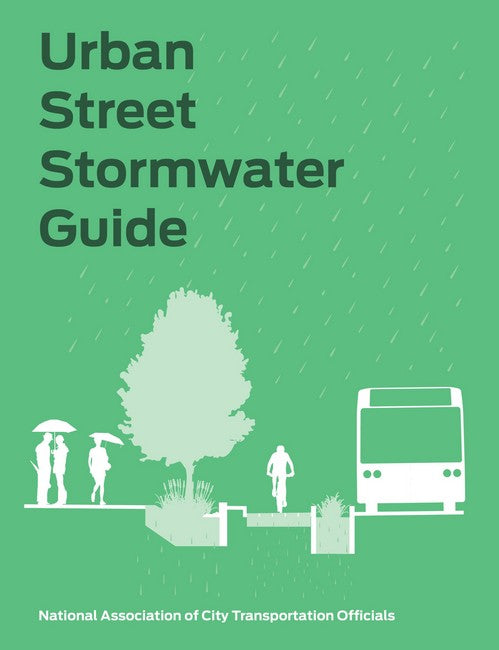About the Guide
How to Use the Guide
NACTO & ASCE
Chapter 1. Streets as Ecosystems
Green Street Principles
Thinking of Streets as Ecosystems
-Placemaking vs. Performance
-Planning the Water Network
-Integrating Green Stormwater Infrastructure
-Regulatory Layers
Chapter 2. Stormwater Streets
The Stormwater Network
-Ultra Urban Green Street
-Green Transitway
-Multi-Way Boulevard
-Neighborhood Main Street
-Neighborhood Street
-Commercial Shared Street
-Residential Shared Street
-Green Alley
-Stormwater Greenway
-Industrial Street
-Reclaimed Intersection
Chapter 3. Designing for Stormwater
General Design Considerations for a Street
Siting GSI in the Right-of-Way
-Planting Strip/Amenity Zone
-Curb Extensions
-Curbside parking/bike lane
-Medians
-Travel Lanes
-Floating BMPs
-Roundabouts
Green Infrastructure Elements
-Bioretention with Graded Side Slopes
-Bioretention with Vertical Walls
-Bioretention with Hybrid Sides
-Tree Wells
-Tree Trenches
-Permeable Pavements
Green Infrastructure Design
-Length of a Bioretention Cell
-Bottom Area
-Soil/Media
-Presettling or Pretreatment
-Inlet/Inflow Design
-Overflow/Outlet Design
-Trees and Plantings
-Subsurface Infrastructure
Chapter 4. Design Considerations
-Street hydrology and stormwater runoff
-Volume Managed vs. Water Quality Design
-Conveyance systems
-Drainage basin type
-Geotechnical/Hydrogeological conditions
-Service and franchise utilities
-Weather/Climate of a region
-Existing infrastructure and adjacent buildings
-Regulatory Framework
Chapter 5. Partnerships & Performance
-Monitoring
-Policy
-Citywide Plans & Strategies for Stormwater Management
-Interdepartmental/Interagency coordination
-Public Outreach
-Operations and Maintenance
Performance Measures
How to Use the Guide
NACTO & ASCE
Chapter 1. Streets as Ecosystems
Green Street Principles
Thinking of Streets as Ecosystems
-Placemaking vs. Performance
-Planning the Water Network
-Integrating Green Stormwater Infrastructure
-Regulatory Layers
Chapter 2. Stormwater Streets
The Stormwater Network
-Ultra Urban Green Street
-Green Transitway
-Multi-Way Boulevard
-Neighborhood Main Street
-Neighborhood Street
-Commercial Shared Street
-Residential Shared Street
-Green Alley
-Stormwater Greenway
-Industrial Street
-Reclaimed Intersection
Chapter 3. Designing for Stormwater
General Design Considerations for a Street
Siting GSI in the Right-of-Way
-Planting Strip/Amenity Zone
-Curb Extensions
-Curbside parking/bike lane
-Medians
-Travel Lanes
-Floating BMPs
-Roundabouts
Green Infrastructure Elements
-Bioretention with Graded Side Slopes
-Bioretention with Vertical Walls
-Bioretention with Hybrid Sides
-Tree Wells
-Tree Trenches
-Permeable Pavements
Green Infrastructure Design
-Length of a Bioretention Cell
-Bottom Area
-Soil/Media
-Presettling or Pretreatment
-Inlet/Inflow Design
-Overflow/Outlet Design
-Trees and Plantings
-Subsurface Infrastructure
Chapter 4. Design Considerations
-Street hydrology and stormwater runoff
-Volume Managed vs. Water Quality Design
-Conveyance systems
-Drainage basin type
-Geotechnical/Hydrogeological conditions
-Service and franchise utilities
-Weather/Climate of a region
-Existing infrastructure and adjacent buildings
-Regulatory Framework
Chapter 5. Partnerships & Performance
-Monitoring
-Policy
-Citywide Plans & Strategies for Stormwater Management
-Interdepartmental/Interagency coordination
-Public Outreach
-Operations and Maintenance
Performance Measures

